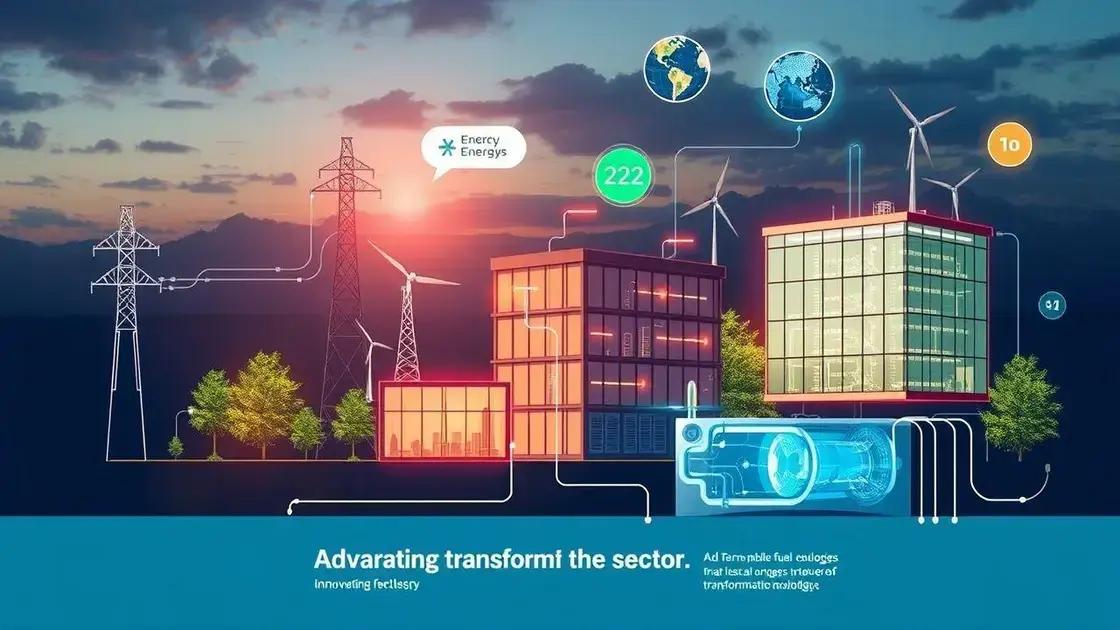News on renewable energy: What to expect this year

Anúncios
Renewable energy sources, such as solar and wind, are essential for reducing greenhouse gas emissions and combating climate change by providing sustainable energy solutions that enhance environmental health.
News on renewable energy keeps us informed about crucial shifts in how we harness and utilize power. Have you ever wondered how these changes impact our daily lives and the planet’s health? Let’s dive in.
Anúncios
Current advancements in renewable energy
Recent advancements in renewable energy are transforming our approach to sustainable power. With innovative technologies emerging, we are witnessing a significant shift towards greener solutions.
Technological Innovations
One of the most exciting areas is the development of more efficient solar panels. These panels now convert sunlight into electricity more effectively than ever, which means more energy can be generated in less time. Additionally, wind turbine technology has advanced, allowing turbines to operate in lower wind speeds, thereby increasing their efficiency.
Energy Storage Solutions
Another important factor is energy storage. With the rise of solar and wind power, storing this energy for later use is crucial. Companies are developing battery technologies that last longer and can store more energy, making renewable energy sources more reliable.
Anúncios
- Battery systems that can last for days instead of hours.
- Research into affordable energy storage options.
- Integration of storage with solar farms and wind parks.
These developments not only make renewable energy more accessible but also help reduce our dependence on fossil fuels. As electric vehicles become more popular, advancements in renewable energy sources play a key role in ensuring these vehicles can operate sustainably.
Government Support and Incentives
Government initiatives are also pushing the envelope. Countries around the world are offering tax credits and grants for renewable energy projects. This support encourages more businesses and homeowners to invest in renewable solutions, making it an attractive option.
In essence, the landscape of energy is changing rapidly. With improved technology, better storage solutions, and supportive regulations, the potential for renewable energy to power our lives has never been greater.
Impact of government policies on renewables
The impact of government policies on renewables is significant and far-reaching. Policies can either promote or hinder advancements in renewable energy technologies. Effective legislation can accelerate the shift towards greener energy sources, encouraging both businesses and consumers to adopt sustainable practices.
Key Policy Initiatives
Many governments are implementing initiatives designed to boost renewable energy. For example, mandates for renewable energy use in power generation are becoming more common. These regulations not only help reduce carbon footprints but also foster innovation in the sector.
- Renewable Portfolio Standards (RPS) encouraging a specific percentage of energy from renewables.
- Tax incentives for installing solar panels or wind turbines.
- Subsidies for research and development in renewable technologies.
In addition to these initiatives, governments often provide financial support to lower the upfront costs of renewable energy projects. This kind of backing helps to make clean energy more accessible for everyone, from small businesses to large corporations.
Long-term Sustainability Goals
Another crucial aspect of government policies is their focus on long-term sustainability goals. Many countries are committing to ambitious targets for carbon neutrality. These commitments drive the market towards renewable energy, as companies work to meet these stringent guidelines. They also create job opportunities in emerging industries, contributing to economic growth.
Additionally, public awareness campaigns play a role by educating citizens about the benefits of renewable energy. When people understand the positive effects on the environment and the economy, they are more likely to support these initiatives. This community backing can further enhance government efforts.
Innovative technologies transforming the industry

Innovative technologies transforming the industry are paving the way for a more sustainable future. These advancements are changing how we generate, distribute, and consume energy, leading to a paradigm shift across various sectors.
Smart Grids
One of the most significant developments is the implementation of smart grids. These are advanced electrical grids that use digital technology to monitor and manage the transport of electricity from all generation sources. By optimizing energy distribution, smart grids improve reliability and efficiency.
- Enable two-way communication between utilities and consumers.
- Support the integration of renewable sources like solar and wind.
- Help prevent outages and manage demand effectively.
This technology ensures that energy is used more efficiently, reducing waste while facilitating the integration of renewable resources.
Energy Efficiency in Buildings
Another trend is how buildings are utilizing innovative technologies to become more energy-efficient. Smart thermostats and energy management systems are helping reduce energy consumption in homes and offices. These systems adjust heating and cooling based on occupancy and weather patterns, optimizing the indoor environment.
Moreover, building materials are evolving. For instance, the use of advanced insulation and energy-efficient windows helps maintain temperature, further decreasing energy needs. As a result, not only are operational costs reduced, but the overall carbon footprint of buildings decreases significantly.
Hydrogen Technology
Hydrogen technology is also making waves in renewable energy. Hydrogen can be produced using renewable sources, offering a clean fuel option for transportation and industry. Fuel cells powered by hydrogen are becoming more popular, providing an emission-free way to generate power.
This technology is still developing, but it’s expected to play a critical role in decarbonizing sectors that are hard to electrify, such as heavy industry and long-haul transportation.
The role of renewable energy in climate change
The role of renewable energy in climate change is crucial as global temperatures rise. Transitioning to renewable energy can significantly reduce greenhouse gas emissions, helping to mitigate the impacts of climate change.
Reducing Carbon Footprint
Renewable energy sources, such as solar, wind, and hydropower, produce little to no emissions during operation. By replacing fossil fuels, which emit high levels of carbon dioxide, these energy sources help lower our overall carbon footprint.
- Solar panels convert sunlight into electricity without harmful emissions.
- Wind turbines harness wind power, providing clean energy with minimal impact.
- Hydropower uses flowing water to generate energy, producing very low emissions.
This transition is essential for achieving international climate goals aimed at limiting global warming to well below 2 degrees Celsius above pre-industrial levels.
Promoting Sustainable Practices
Using renewable energy also promotes sustainable practices across industries. As companies adopt cleaner energy sources, they encourage environmental responsibility and sustainability. This shift can lead to innovative technologies and practices that further reduce emissions.
Furthermore, renewable energy can provide energy security. By diversifying our energy sources and relying less on imported fossil fuels, countries can enhance their energy independence. This is particularly important in the face of increasing environmental policies and climate agreements.
Community Benefits
Emphasizing renewable energy can bring economic and social benefits to communities. Job creation in renewable energy sectors can stimulate local economies. As more people have access to green jobs, communities can thrive while tackling climate issues.
Moreover, increased use of renewable energy reduces health risks associated with air pollution from fossil fuels, leading to a healthier population.
Future prospects for renewable energy sources
The future prospects for renewable energy sources look promising as technology continues to evolve. Innovations in energy production and storage are driving the expansion of renewables worldwide.
Emerging Technologies
New technologies are being developed to improve the efficiency of existing renewable energy sources. For example, advancements in solar panel efficiency allow for more energy production with less land use. Researchers are also exploring higher-capacity batteries that can store more energy for longer periods, making renewable energy more reliable during peak demand times.
- Next-generation solar cells, including perovskite solar cells, promise higher efficiency.
- Advanced storage solutions like lithium-sulfur batteries could revolutionize energy management.
- Hydrogen production from renewable sources is becoming more viable.
These technologies can play a key role in introducing more sustainable energy options to the market.
Policy Support and Incentives
Government policies are also pivotal for the future of renewable energy. Many countries are setting ambitious targets for reducing carbon emissions, which spur investments in renewables. Financial incentives, such as tax credits and rebates, encourage both businesses and households to adopt renewable technologies.
Collaboration between governments, industry, and research institutions is necessary to advance these initiatives. Public-private partnerships can accelerate innovation and bring new projects to fruition.
Global Trends
On a global scale, there is a noticeable shift towards greener energy solutions. Countries are increasingly recognizing the importance of energy independence and sustainability. This leads to greater investments in renewable resources such as solar, wind, and geothermal.
As the cost of renewable technologies continues to decrease, they become more accessible to a wider range of users. This trend will expand the deployment of renewable energy worldwide.
FAQ – Frequently Asked Questions about Renewable Energy
What are renewable energy sources?
Renewable energy sources include solar, wind, hydro, geothermal, and biomass; they replenish naturally and help reduce greenhouse gas emissions.
How does renewable energy help combat climate change?
By replacing fossil fuels with renewable energy, we significantly lower carbon emissions, which are a major contributor to climate change.
What technologies are driving renewable energy advancements?
Innovative technologies like smart grids, advanced solar panels, and energy storage systems are enhancing the efficiency and accessibility of renewable energy.
Is government support important for renewable energy expansion?
Yes, government policies and incentives play a crucial role in promoting renewable energy adoption and supporting the development of new technologies.





